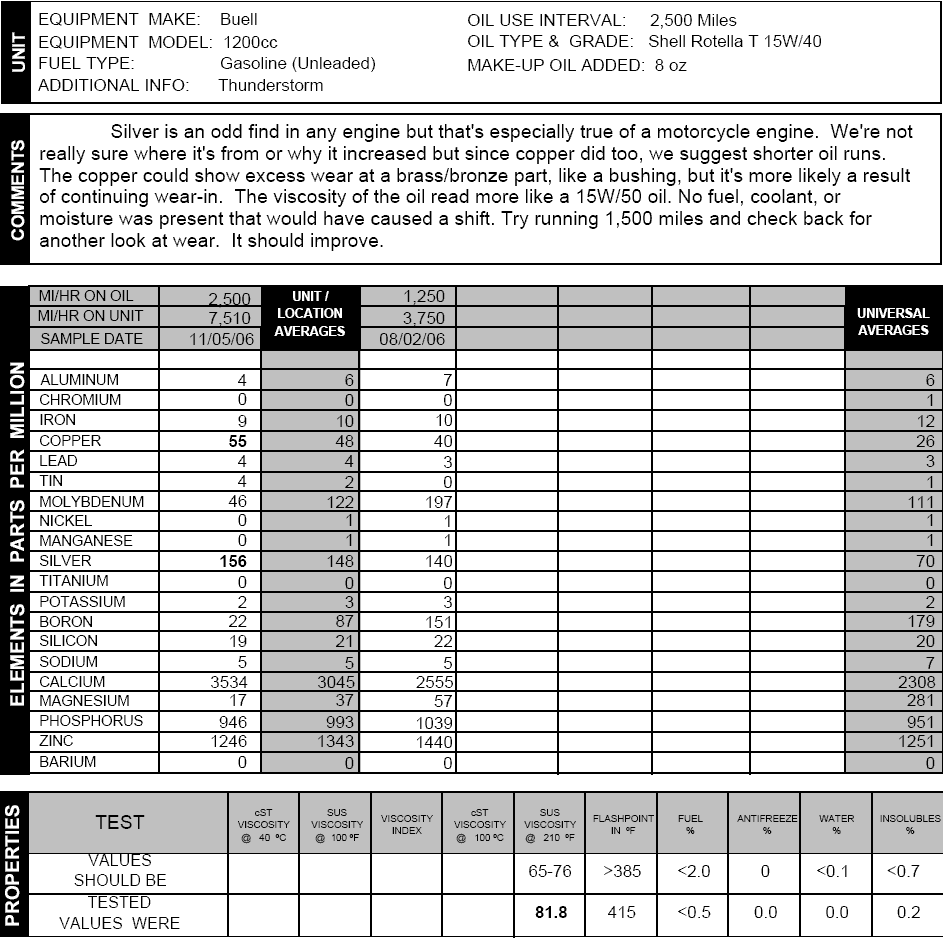| Author | Message | ||
Az_rider |
Ulysses XB12X, 7500 miles on bike, 2500 miles on oil. Bike is stock. Any ideas on the copper and silver? I can find only one other Oil Report for a Buell, and their copper was high too, but they did not post the value for silver. Reports for Harleys do not show copper or silver, so it seems specific to Buells. I was told the oil cooler (and silver solder) could be causing these values to be high. Insolubles, aluminum, and iron are good, so I would be surprised if it was a lubrication problem. Thoughts?  | ||
Sloppy |
Do you use anti-sieze anywhere on the engine? Your viscocity numbers look great and you still have a good level of an additive package in the oil -- a good example of how wastefull it can be to change oil too early. Imagine there are folks who change their oil every 1000 miles and your analysis, so far, is showing your intervals to be at least 4000 miles! The cheap cost and convenience of an oil analysis is well worth the investment. And once you've developed a baseline, you can reduce the number of times you have to do an oil analysis. | ||
Reepicheep |
Cool! What did the 06 internal engine bearing change consist of? Didn't they change to sliver bearings or something? It was some of the trickle down from the race program. They change to that new previously unobtanium oil pump drive gear as well... wonder what that is made of? | ||
Bomber |
I think the new gear is bronze, or an alloy thereof (if that's possible, since bronze is already an alloy ;-} ) | ||
Blake |
 | ||
Naustin |
If the oil pump drive gear is bronze, then wouldn't that be an obvious culprit for the copper numbers? | ||
Sloppy |
There's plenty of brass in the engine. Cam bushings, bearing races, etc. It's likely part of the break in period -- and the numbers are not exceedingly high. Anyways, you have to consider what the analysis company use for a baseline -- automotive engines (likely) or air cooled engines (not-likely)... | ||
Blake |
Bearing races are brass? Which ones? | ||
Sloppy |
Sorry, that should be bearing "cage", not race... my bad. While some cages are made out of plastic or steel, many cages come in brass. A bad experience with ammonia refrigeration taught me that one... | ||
Ara |
It occurred to me that one could use litmus paper to measure the acidity of motor oil. I think I change my motor oil too frequently, and I thought that measuring the acidity of the oil might help me decide when it's time. Has anybody ever tried this? What do you think? | ||
Jlnance |
Ara - Good question, I do not know. I do know that litmus paper, and the whole concept of pH in general, assumes everything is disolved in water. Since oil does not disolve in water, you're not just going to be able to stick the litmus paper in and get a meaninful result. | ||
Ara |
Jim, Oh, I didn't know that litmus paper only works in water. Another fine idea succumbs to the rigors of reality! Thanks for your response. Russ | ||
Az_rider |
Here is an update: The bike now has 10,000 miles and the oil tested had 2500 miles of use. The amount of silver and copper dropped 25% from the last analysis.  |